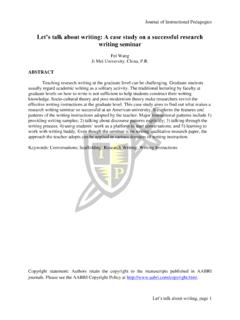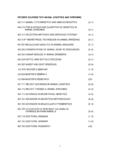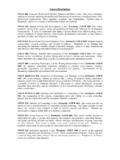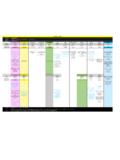Transcription of Design For Automatic Assembly-
1 TRITA-IIP-01-02 ISSN 1650-1888 doctoral THESIS DIVISION OF assembly SYSTEMS DEPT. OF PRODUCTION ENGINEERING STOCKHOLM 2001 ROYAL INSTITUTE OF TECHNOLOGY K T H Stephan Eskilander - Design For Automatic assembly A Method For Product Design : DFA2 2001 Design For Automatic assembly - A Method For Product Design : DFA2 DFA2 DFA2 DFA2 DFA2 STEPHAN ESKILANDER Design FOR Automatic assembly - A Method For Product Design : DFA2 A doctoral Thesis by Stephan Eskilander Wox ncentrum a NUTEK competence centre for efficient and easily changeable production TRITA-IIP-01-02 ISSN 1650-1888 Stephan Eskilander Wox ncentrum / assembly Systems Division Department of Production Engineering Royal Institute of Technology S-100 44 Stockholm, Sweden Stockholm 2001, KTH H gskoletryckeriet iii Abstract This thesis presents a method that supports product developers and Design teams to Design products for Automatic assembly .
2 Product development nowadays is often carried out in parallel to, for example, shorten the development time. Working with product development in parallel implies a need for support methods that focus activities throughout the product life cycle. By focusing the assembly process in product development there is a potential for developing more assembly friendly products. To develop a product that is possible to assemble automatically implies reduced number of parts, preferably only one assembly direction and parts that are easy to feed. Techniques known as Design For assembly , DFA, have been used since the early eighties.
3 Most DFA methods are focused on product evaluation. There is, naturally, a need to evaluate products, but few DFA methods provide the user with information on how to Design the product to avoid assembly problems. The method presented, DFA2, is based on a collection of Design rules, to provide information to the users on how to Design the product. The Design rules are aimed at Automatic assembly , DFAA, Design For Automatic assembly (A product designed for Automatic assembly will also be easy to assemble manually.) The Design rules are sequenced, starting with information regarding the whole object and continue with information for each part in the product.
4 The structure of DFA2 is a way to provide the user with right information at the right time and makes sure that no information is overlooked. Combined with the Design rules, DFA2 includes qualitative evaluation criteria since this type of evaluation also tells how to do instead, not only how good or bad the Design is. A method that consists of Design rules and qualitative evaluation is ideal to use in the early product development stages. DFA2 also provides the users with a common language that simplifies parallel product development in teamwork between designers, production engineers, quality engineers, purchasers, logistics specialists and so on.
5 DFA2 supports product developers to focus their attention on avoiding one potential assembly problem at the time, in a structured way. Furthermore, DFA2 supports cost analysis to reveal the costs connected with the Design concepts. The cost analysis is based on an activity analysis, which also brings product Design closer to assembly system Design . v Contents 1 WHAT IS THE PROBLEM? .. 13 INCREASING 13 PRODUCT 14 INITIAL PROBLEM 19 2 WHAT IS Design FOR assembly , DFA? .. 21 BACKGROUND FOR DFA .. 21 DFX AND OTHER ACRONYMS, WHAT IS THE DIFFERENCE?
6 22 EFFECTS OF DFA .. 26 BENCHMARKING WITH 29 HOW TO IMPLEMENT DFM OR 30 WHY IS NOT DFA USED MORE?.. 32 POSSIBLE DRAWBACKS WITH DFA .. 33 IMPLICATIONS FOR THIS 34 3 RELATED WORK .. 35 GENERAL Design 35 EVALUATION PHILOSOPHIES IN DFA .. 37 DFA METHODS WITH QUALITATIVE 41 DFA METHODS WITH QUANTITATIVE 51 WHAT IS MISSING? .. 56 IMPLICATIONS FOR THIS 57 4 RESEARCH ASPECTS .. 59 OBJECTIVES AND SCOPE OF THIS 60 RESEARCH 61 ACADEMIC 65 INDUSTRIAL 66 5 DEVELOPMENT OF A DFAA 69 Automatic assembly : PRODUCT 69 AN IDEAL DFA TOOL - A CASE 70 APPROACH FOR THE DFAA 72 EVALUATION PHILOSOPHY FOR 77 Design RULES AND STRUCTURE IN DFA2.
7 78 DFA2 79 DFA2 81 ILLUSTRATIVE EXAMPLE OF DFA2 .. 81 PRODUCT 85 EXAMPLE OF DFA2 TEST 90 vi 6 ECONOMIC 93 DIFFERENT 93 COST ESTIMATION MODELS FOR 96 ACTIVITY BASED COST ESTIMATIONS IN 105 7 DISCUSSION .. 117 PRODUCT Design AND assembly 117 DFA2 DEVELOPS WITHIN A 118 PROCESS DRIVEN PRODUCT 119 DFA2 SUPPORTS CONCURRENT 120 OBJECTIVE 121 TIME 122 123 PRIORITISING EVALUATION 124 8 CRITICAL REVIEW AND FUTURE RESEARCH .. 125 CRITICAL REVIEW OF THE 125 CONCLUDING 134 FUTURE 136 9 REFERENCES.
8 137 APPENDIX: THE DFA2 METHOD .. 153 SECTION 1, PRODUCT 154 SECTION 2, PART 164 DATA SHEET FOR PRODUCT 186 DATA SHEET FOR PART 187 DATA SHEET FOR COST 189 vii Earlier publications Focus on DFA: Eskilander, S., Byron Carlsson, T., Monteringsv nlig produktutformning f rstudie f r utveckling av ett ingenj rsverktyg , Wox nrapport 18, ISSN 1402-0718, 1998 (In Swedish) Byron Carlsson, T., Erixon G., Eskilander, S., Johansson, R., Peterson, P., A flowchart method for Design for Automatic assembly , The 1998 international forum on DFMA, 1998 Byron Carlsson, T.
9 , Eskilander, S., Johansson, R., Peterson, P., A structured set of concrete Design rules for Design for Automatic assembly Proceedings of the 31st ISATA conference, 1998 Eskilander, S., Design for Automatic assembly development of a rule based method , Licentiate thesis, ISSN 1104-2141, 1999 Eskilander, S., DFA2 En metod f r att utveckla monteringsv nliga produkter , Wox nrapport 27, ISSN 1402-0718, 2000 (In Swedish) Eskilander, S., Gr ndahl, P., Bergdahl, A., A rule based Design method for Automatic assembly description and industrial application , The 2000 international forum on DFMA, 2000 Eskilander, S.
10 , DFA2- ett verktyg f r enkel montering , Verkst derna, No 8, 2000 (In Swedish) Eskilander, S., Mass production of fuel cells requirements and preconditions for the assembly process , IVF-rapport 00012, 2000 Eskilander, S., DFA2 En metod f r monteringsv nlig produktutveckling och kostnadsanalys , Wox nrapport 33, ISSN 1650-1888, 2001 (In Swedish) viii OTHER: Eskilander, S., Langbeck, B., Onori, M., Industrial applications of a new FAA machine , 1st IFAC workshop on intelligent assembly and disassembly , IAD, 1998 Langbeck, B.




